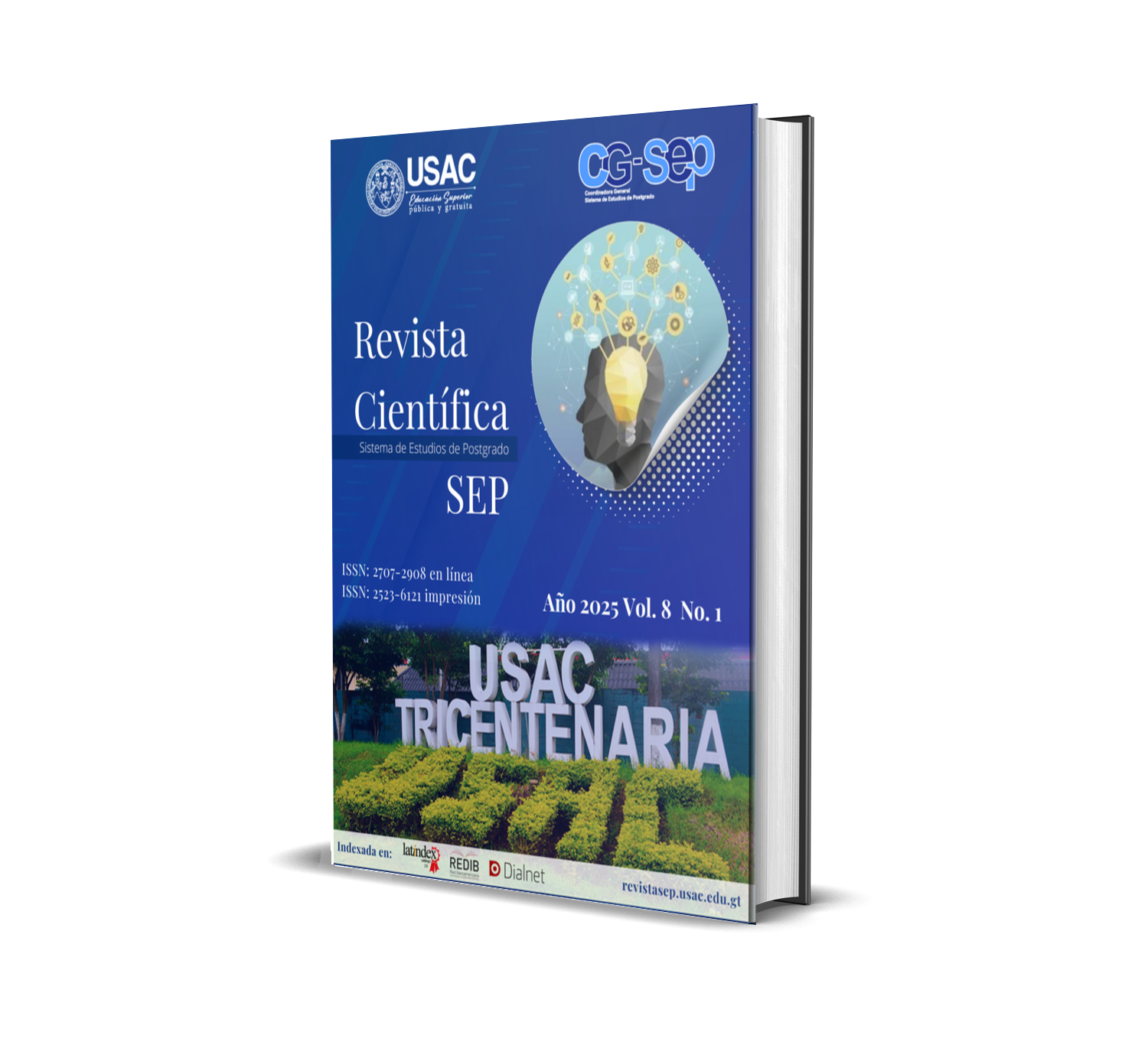Participation, adherence to medical treatment, health status and nutrition in chronic disease clubs
DOI:
https://doi.org/10.36958/sep.v8i1.322Keywords:
chronic non-communicable diseases, adherence to treatment, health status, nutritional status, level of participationAbstract
OBJECTIVE: determine the relationship between the participation level, adherence to medical treatment, health status and nutrition of patients from Chronic Non-Communicable Diseases (NCDs) clubs, in territory I of the Municipal Health District of Casillas, Santa Rosa. METHOD: a descriptive cross-sectional study was conducted, with a stratified probabilistic sampling, for which 193 patients with High Blood Pressure (HBP) and/or Diabetes Mellitus (DM) were selected; the data reported from the file, the interview carried out and the Morisky Green test were taken. The relationship between variables was analyzed in the SPSS Statistics program version 29.01.0.(171) using Pearson’s evaluation coefficient with a statistical significance level of p<0.05. RESULTS: the majority presented a medium level of participation (44%), whether they were adherent to medical treatment (56%), had adequate health status (54%) and obesity (37.9%). The level of participation was related to medical treatment adherence (r= 0.307; p<0.001) and health status (r=0.698; p<0.001). Likewise, adherence to medical treatment with health status (r=0.413; p <0.001) and nutrition (r=-0.237; p=0.027). Participation level was not related to nutritional status (r=-0.036; p=0.737). Likewise, health and nutrition status (r=--0.082; p=0.449). CONCLUSION: there was a statistically significant relationship with a 95% confidence level between participation level, adherence to medical treatment, and health status. Nutritional status was not statistically related to participation level or health status, only to adherence to medical treatment.
Downloads
References
Álvarez, C., Brito Tola, M. A. Y Carpio Durán, A. L. (2013). Adherencia al tratamiento farmacológico hipertensivo en pacientes diagnosticados de diabetes mellitus tipo 2 [tesis de licenciatura, Universidad de Azuay]. http://dspace.uazuay.edu.ec/handle/datos/2771
Durán, A., Valderrama, L., Uribe, A. F., González, A. y Molina, J. M. (2010). Enfermedad crónica en adultos mayores. Univ. Méd, 51 (1), 16-28. https://www.redalyc.org/pdf/2310/231018676003.pdf DOI: https://doi.org/10.11144/Javeriana.umed51-1.ecam
Flores Acero, A.A. (2019). Adherencia al Tratamiento y Control de la Glicemia en Pacientes con Diagnóstico de Diabetes Mellitus Tipo 2 Atendidos en el Programa de Diabetes e Hipertensión del Hospital Hipólito Unanue de Tacna [tesis de licenciatura, Universidad Privada de Tacna]. Repositorio UPT-Institucional. https://repositorio.upt.edu.pe/handle/20.500.12969/685
Instituto de Nutrición de Centro América y Panamá. (2016). Recomendaciones para el consumo de frutas en ambientes recreativos y de trabajo. https://www.incap.int/index.php/es/frutas
Instituto Nacional de Higiene Rafael Rangel (2014). Relación entre hábitos nutricionales y enfermedades crónicas. Revista del Instituto Nacional de Higiene Rafael Rangel, 45(1), 6-8. https://ve.scielo.org/scielo.php?script=sci_arttext&pid=S0798-04772014000100001
Ministerio de Salud Pública y Asistencia Social (MSPAS)/Departamento de Regulación de los Programas de Atención a las Personas (DRPAP) (2023). Lineamientos para implementar intervenciones y seleccionar medicamentos para atender las 2023 morbilidades de enfermedades crónicas no transmisibles. Programa Nmacional para la Prevención de Enfermedades Crónicas No Transmisibles y Cáncer. https://drive.google.com/file/d/1eCtRAZq9VFXgjYfB3LfLv2T5RxkboVcp/view
Neves Júnior, T. T., Rego de Queiroz, A, A. Araújo de Carvalho. E., Assis Silva, C. J., Nóbrega Elias, T. M. y Paiva de Menezes, R.M. (2023). Perfil clínico y sociodemográfico de usuarios con enfermedades crónicas en atención primaria de salud. Enfermería Global, 22(69), 245-282. https://dx.doi.org/10.6018/eglobal.512211 DOI: https://doi.org/10.6018/eglobal.512211
Organización Panamericana de la Salud (27 de enero de 2023). Enfermedades Crónicas No Transmisibles. https://www.paho.org/es/temas/enfermedades-no-transmisibles#:~:text=Las%20enfermedades%20no%20transmisibles%20(ENT)%20matan%20a%2041%20millones%20de,muertes%20por%20ENT%20cada%20a%C3%B1o.
Ortega Cerda, J.J., Sánchez Herrera, D., Rodríguez Miranda, O. A. y Ortega Legaspi, J. M. (2018). Adherencia terapéutica: un problema de atención médica. Acta Médica Grupo Ángeles, 16(3), 226-232. https://www.scielo.org.mx/scielo.php?script=sci_arttext&pid=S1870-72032018000300226
Robalino Gualoto, R.S., Palzzi Trebols, N. M., Aldaz Vargas., L. F., Cabay Cabay, G. J. y Chicaiza, Samaniego, P. F. (2022). Programa educativo de autocuidado para pacientes con diabetes mellitus tipo II. Revista de investigación talentos, 9(1),2631-2476. https://dialnet.unirioja.es/servlet/articulo?codigo=8551304 DOI: https://doi.org/10.33789/talentos.9.1.157
Rodríguez Araújo (2018). Orientaciones para el trabajo con grupos de apoyo y grupos de ayuda mutua. Subdirección de enfermedades no transmisibles. Primera Editorial. https://www.minsalud.gov.co/sites/rid/Lists/BibliotecaDigital/RIDE/VS/PP/ENT/Orientaciones-grupos-apoyo-ayuda-mutua.pdf
Rodríguez Ulcuango, L. A. (2020). Adherencia terapéutica en diabéticos e hipertensos que acuden al club de apoyo versus quienes solo acuden a consulta externa del Centro de Salud Guamaní, noviembre 2018 – febrero 2019. Tr. Universidad Central del Ecuador. https://www.dspace.uce.edu.ec/server/api/core/bitstreams/f41f0a23-d856-4f68-9efe-8d8efb2f6c78/content
Sistema de Información Gerencial en Salud (SIGSA). (2022). Enfermedades crónicas, casos de morbilidad y mortalidad por crónicas. https://sigsa.mspas.gob.gt/datos-de-salud/morbilidad/enfermedades-cronicas
Published
How to Cite
Issue
Section
License
Copyright (c) 2025 Clarissa Nineth Andrea Gómez Hernández

This work is licensed under a Creative Commons Attribution 4.0 International License.
The authors who publish in this journal accept the following conditions:
- The authors retain the copyright and assign to the journal the right of the first publication, with the work registered with the Creative Commons 4.0 attribution license, which allows third parties to use what is published as long as they mention the authorship of the work already the first publication in this magazine.
- Authors may make other independent and additional contractual agreements for the non-exclusive distribution of the version of the article published in this journal (eg, include it in an institutional repository or publish it in a book) provided that they clearly indicate that the work it was first published in this magazine.
- Authors are allowed and encouraged to share their work online (for example: in institutional repositories or personal web pages) before and during the manuscript submission process, as it can lead to productive exchanges, more and more quick citation of published work (see The Effect of Open Access).









